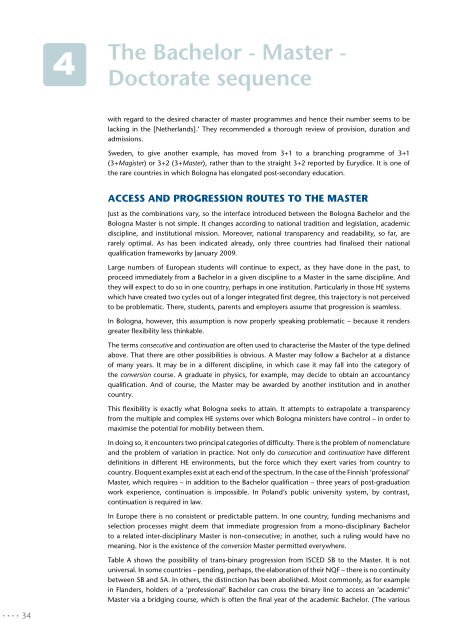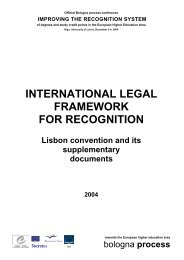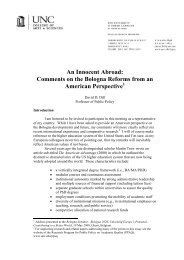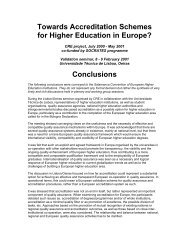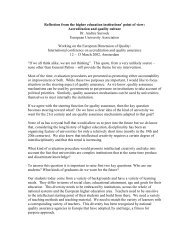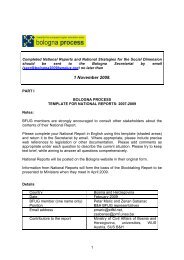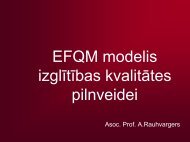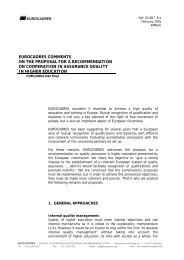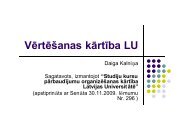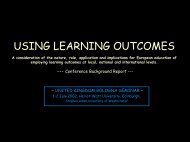EUA Survey Of Master Degrees In Europe - European University ...
EUA Survey Of Master Degrees In Europe - European University ...
EUA Survey Of Master Degrees In Europe - European University ...
Create successful ePaper yourself
Turn your PDF publications into a flip-book with our unique Google optimized e-Paper software.
4The Bachelor - <strong>Master</strong> -Doctorate sequencewith regard to the desired character of master programmes and hence their number seems to belacking in the [Netherlands].’ They recommended a thorough review of provision, duration andadmissions.Sweden, to give another example, has moved from 3+1 to a branching programme of 3+1(3+Magister) or 3+2 (3+<strong>Master</strong>), rather than to the straight 3+2 reported by Eurydice. It is one ofthe rare countries in which Bologna has elongated post-secondary education.Access and progression routes to the <strong>Master</strong>Just as the combinations vary, so the interface introduced between the Bologna Bachelor and theBologna <strong>Master</strong> is not simple. It changes according to national tradition and legislation, academicdiscipline, and institutional mission. Moreover, national transparency and readability, so far, arerarely optimal. As has been indicated already, only three countries had finalised their nationalqualification frameworks by January 2009.Large numbers of <strong>Europe</strong>an students will continue to expect, as they have done in the past, toproceed immediately from a Bachelor in a given discipline to a <strong>Master</strong> in the same discipline. Andthey will expect to do so in one country, perhaps in one institution. Particularly in those HE systemswhich have created two cycles out of a longer integrated first degree, this trajectory is not perceivedto be problematic. There, students, parents and employers assume that progression is seamless.<strong>In</strong> Bologna, however, this assumption is now properly speaking problematic – because it rendersgreater flexibility less thinkable.The terms consecutive and continuation are often used to characterise the <strong>Master</strong> of the type definedabove. That there are other possibilities is obvious. A <strong>Master</strong> may follow a Bachelor at a distanceof many years. It may be in a different discipline, in which case it may fall into the category ofthe conversion course. A graduate in physics, for example, may decide to obtain an accountancyqualification. And of course, the <strong>Master</strong> may be awarded by another institution and in anothercountry.This flexibility is exactly what Bologna seeks to attain. It attempts to extrapolate a transparencyfrom the multiple and complex HE systems over which Bologna ministers have control – in order tomaximise the potential for mobility between them.<strong>In</strong> doing so, it encounters two principal categories of difficulty. There is the problem of nomenclatureand the problem of variation in practice. Not only do consecution and continuation have differentdefinitions in different HE environments, but the force which they exert varies from country tocountry. Eloquent examples exist at each end of the spectrum. <strong>In</strong> the case of the Finnish ‘professional’<strong>Master</strong>, which requires – in addition to the Bachelor qualification – three years of post-graduationwork experience, continuation is impossible. <strong>In</strong> Poland’s public university system, by contrast,continuation is required in law.<strong>In</strong> <strong>Europe</strong> there is no consistent or predictable pattern. <strong>In</strong> one country, funding mechanisms andselection processes might deem that immediate progression from a mono-disciplinary Bachelorto a related inter-disciplinary <strong>Master</strong> is non-consecutive; in another, such a ruling would have nomeaning. Nor is the existence of the conversion <strong>Master</strong> permitted everywhere.Table A shows the possibility of trans-binary progression from ISCED 5B to the <strong>Master</strong>. It is notuniversal. <strong>In</strong> some countries – pending, perhaps, the elaboration of their NQF – there is no continuitybetween 5B and 5A. <strong>In</strong> others, the distinction has been abolished. Most commonly, as for examplein Flanders, holders of a ‘professional’ Bachelor can cross the binary line to access an ‘academic’<strong>Master</strong> via a bridging course, which is often the final year of the academic Bachelor. (The various34


